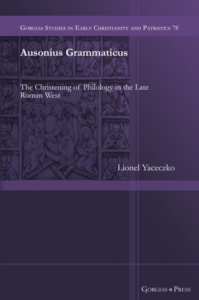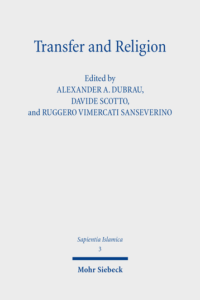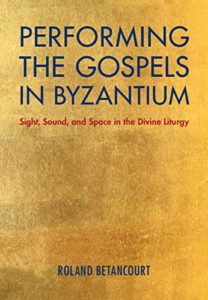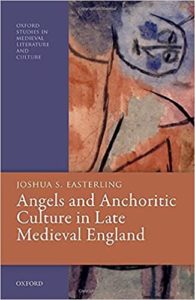Monthly Updates on Recent Books in the History of Christianity
To raise awareness of recent books in the history of Christianity, the editorial staff of Church History: Studies in Christianity and Culture highlights each month a list of 10-15 books in diverse periods and geographical regions that we hope will be of interest to our members. We include here below the fifteenth monthly list, chosen by our staff, with excerpts from the publishers’ blurbs.

Lionel Yaceczko, Ausonius Grammaticus: The Christening of Philology in the Late Roman West. 2021
The present volume describes the rich and complex world in which Ausonius (c. 310-395) lived and worked, from his humble beginnings as a schoolteacher in Bordeaux, to the heights of his influence as quaestor to the Emperor Gratian, at a time of unsettling social and religious change. As a teacher and poet Ausonius adhered to the traditions of classical paideia, standing in contrast to the Fathers of the Church, e.g., Jerome, Augustine, and Paulinus of Nola, who were emboldened by the legalization, then the imposition, of Christianity in the course of the fourth century. For this position he was labeled by the 20th-century scholar Henri-Irénée Marrou a symbol of decadence. Guided by Marrou's critical insights to both his own time and place and that of Ausonius, this book proposes a hermeneutic for reading Ausonius as both a fourth-century poet and a fascinating mirror for his 20th-century counterparts.

Douglas A. Foster, A Life of Alexander Campbell. 2020
Life of Alexander Campbell examines the core identity of a gifted and determined reformer to whom millions of Christians around the globe today owe much of their identity—whether they know it or not.
Douglas Foster assesses principal parts of Campbell’s life and thought to discover his significance for American Christianity and the worldwide movement that emerged from his work. He examines Campbell’s formation in Ireland, his creation and execution of a reform of Christianity beginning in America, and his despair at the destruction of his vision by the American Civil War. A Life of Alexander Campbell shows why this important but sometimes misunderstood and neglected figure belongs at the heart of the American religious story.

Walter Stevenson, The Origins of Roman Christian Diplomacy: Constantius II and John Chrysostom as Innovators. 2021
This book illuminates the origins of Roman Christian diplomacy through two case studies: Constantius II’s imperial strategy in the Red Sea; and John Chrysostom's ecclesiastical strategy in Gothia and Sasanian Persia.
Both men have enjoyed a strong narrative tradition: Constantius as a persecuting, theological fanatic, and Chrysostom as a stubborn, naïve reformer. Yet this tradition has often masked their remarkable innovations. As part of his strategy for conquest, Constantius was forced to focus on Alexandria, demonstrating a carefully orchestrated campaign along the principal eastern trade route. Meanwhile, whilst John Chrysostom' s preaching and social reform have garnered extensive discussion, his late sermons and letters composed in exile reveal an ambitious program to establish church structures outside imperial state control.
The book demonstrates that these two pioneers innovated a diplomacy that utilised Christianity as a tool for forging alliances with external peoples; a procedure that would later become central to Byzantine statecraft. It will appeal to all those interested in Early Christianity and late antique/medieval history.

Alexander A. Dubrau, Davide Scotto, and Ruggero Vimercati Sanseverino, eds. Transfer and Religion: Interactions between Judaism, Christianity, and Islam from the Middle Ages to the Twentieth Century. 2020
This collaboration brings into conversation scholars of Jewish and Islamic studies, theologians, and cultural historians to shed new light on the enduring intertwining between the Abrahamic faiths in the Mediterranean and Central Europe since the Middle Ages. Drawing on interdisciplinary expertise, the volume presents a series of case studies reflecting – in either a constructive or a disruptive way – the interactions between the dynamics of transfer and the role of religion in society. The long durée of the book's chronology helps outline the making of religious transfers in the medieval times and their transformations up to the twentieth-century challenges of nationalism and secularism. Considering a variety of distinct implications and reactions to religious transfer, the volume contributes to pinpointing past and present challenges towards religious conceptions, doctrines and narratives in the interaction between Judaism, Christianity, and Islam

Joseph P. Chinnici, American Catholicism Transformed: From the Cold War Through the Council. 2021
Situating the church within the context of post-World War II globalization and the Cold War, American Catholicism Transformed draws on previously untapped archival sources to provide deep background to developments within the American Catholic Church in relationship to American society at large. Shaped by anti-communist sentiment and responsive to American cultural trends, the Catholic community adopted "strategies of domestic containment," stressing the close unity between the Church and the "American way of life." A focus on the unchanging character of God's law as expressed in social hierarchies of authority, race, and gender provided a public visage of unity and uniformity. However, the emphasis on American values mainstreamed into the community the political values of personal rights, equality, acceptance of the arms race, and muted the Church's inherited social vision. The result was a deep ambivalence over the forces of secularization.
The Catholic community entered a transitional stage in which "those on the right" and "those on the left" battled for control of the Church's vision. International networking, reform of religious life among women, international congresses of the laity, the institutionalization of the liturgical movement, and the burgeoning civil right movement positioned the community to receive the Vatican Council in a distinctly American way. During the Second Vatican Council, the American bishops and theological experts gradually adopted the reforming currents of the world-wide Church. This convergence of international and national forces of renewal -- and resistance to them -- says Joseph Chinnici, will continue to shape the American Catholic community's identity in the twenty-first century.

Eilish Gregory, Catholics during the English Revolution, 1642-1660: Politics, Sequestration and Loyalty. 2021
This is the first book to examine thoroughly the ways in which Catholics adapted to political and social change during the turbulent years of the English Revolution. The book examines several important aspects of the Catholic experience in this period. It explores the penal laws by which the estates of Catholics were sequestrated, discussing the extent to which politicians designed the new laws to target Catholics specifically, rather than Royalists more generally, and outlining how the sequestration legislation operated in practice. It considers how Catholic gentry utilised their networks with influential Protestants with wider political connections when applying to have their sequestrations discharged. More broadly the book reveals how Catholics demonstrated their loyalty and assimilated into society despite being viewed as the natural enemies of the English Republic and Protectorate. The book also compares Catholic experiences to those of other religious minorities and sets the situation in England in the wider European international context of Catholic-Protestant rivalry and warfare, which made Catholics a particularly vulnerable religious minority in Puritan England.

Roland Betancourt, Performing the Gospels in Byzantium: Sight, Sound, and Space in the Divine Liturgy. 2021
Tracing the Gospel text from script to illustration to recitation, this study looks at how illuminated manuscripts operated within ritual and architecture. Focusing on a group of richly illuminated lectionaries from the late eleventh century, the book articulates how the process of textual recitation produced marginalia and miniatures that reflected and subverted the manner in which the Gospel was read and simultaneously imagined by readers and listeners alike. This unique approach to manuscript illumination points to images that slowly unfolded in the mind of its listeners as they imagined the text being recited, as meaning carefully changed and built as the text proceeded. By examining this process within specific acoustic architectural spaces and the sonic conditions of medieval chant, the volume brings together the concerns of sound studies, liturgical studies, and art history to demonstrate how images, texts, and recitations played with the environment of the Middle Byzantine church.

Rebecca L. Davis, Public Confessions: The Religious Conversions That Changed American Politics. 2021
University of North Carolina Press
Personal reinvention is a core part of the human condition. Yet in the mid-twentieth century, certain private religious choices became lightning rods for public outrage and debate.
Public Confessions reveals the controversial religious conversions that shaped modern America. Rebecca L. Davis explains why the new faiths of notable figures including Clare Boothe Luce, Whittaker Chambers, Sammy Davis Jr., Marilyn Monroe, Muhammad Ali, Chuck Colson, and others riveted the American public. Unconventional religious choices charted new ways of declaring an “authentic” identity amid escalating Cold War fears of brainwashing and coercion. Facing pressure to celebrate a specific vision of Americanism, these converts variously attracted and repelled members of the American public. Whether the act of changing religions was viewed as selfish, reckless, or even unpatriotic, it provoked controversies that ultimately transformed American politics.
Public Confessions takes intimate history to its widest relevance, and in so doing, makes you see yourself in both the private and public stories it tells.

Joshua S. Easterling, Angels and Anchoritic Culture in Late Medieval England. 2021
This volume examines Latin and vernacular writings that formed part of a flourishing culture of mystical experience in the later Middle Ages (ca. 1150DS1400), including the ways in which visionaries within their literary milieu negotiated the tensions between personal, charismatic inspiration and their allegiance to church authority. It situates texts written in England within their wider geographical and intellectual context through comparative analyses with contemporary European writings. A recurrent theme across all of these works is the challenge that a largely masculine and clerical culture faced in the form of the various, and potentially unruly, spiritualities that emerged powerfully from the twelfth century onward. Representatives of these major spiritual developments, including the communities that fostered them, were often collaborative in their expression. For example, holy women, including nuns, recluses, and others, were recognized by their supporters within the church for their extraordinary spiritual graces, even as these individual expressions of piety were in many cases at variance with securely orthodox religious formations. These writings become eloquent witnesses to a confrontation between inner, revelatory experience and the needs of the church to set limitations upon charismatic spiritualities that, with few exceptions, carried the seeds of religious dissent. Moreover, while some of the most remarkable texts at the centre of this volume were authored (and/or primarily read) by women, the intellectual and religious concerns in play cut across the familiar and all-too-conventional boundaries of gender and social and institutional affiliation.

Rosemary Moore, George Whitehead and the Establishment of Quakerism. 2021
George Whitehead was a key figure in Quakerism from around 1660 until his death in 1723, but he has been neglected in recent scholarship. He was an effective political lobbyist in the struggle for religious toleration and was active in the developing work of the national Quaker bodies, Yearly Meeting, Meeting for Sufferings, and the Morning Meeting. He was also a leader in the adaptation of Quaker theology to the needs of the late seventeenth century. In his old age he was involved in the campaign to permit Quakers to use a form of affirmation instead of judicial oaths. This study by Rosemary Moore begins with an account of his life, using his memoirs and other contemporary sources, continues with a consideration of his published works, including his understanding of the ‘light within’, and concludes with a look at his place in Quaker history in comparison with George Fox and William Penn.

John W. O’Malley, The Education of a Historian: A Strange and Wonderful Story. 2021
Saint Joseph’s University Press
In this autobiographical memoir, John W. O'Malley recounts how his life-story is unintelligible apart from his craft as an historian and from the passion his craft inspired. The narrative is the straightforward story of how a young man of modest background from a small town in Ohio achieved international eminence as a historian of the religious culture of modern Europe. In some detail, therefore, this book tells how four of the twelve monographs that O'Malley published during his career had field-changing influence: Praise and Blame in Renaissance Rome (1979), The First Jesuits (1993), Trent and All That (2000), and What Happened at Vatican II (2008). The book is, however, much more than a tedious review of scholarship. It teaches the reader lessons in historical method and lessons in what good history does for us. They are lessons easy to digest because they are taught not by abstract principles, but by following a historian in action as he learns in fits and starts how to interpret the past in ways that do less injustice to it than other ways.

Carolyn Muessig, The Stigmata in Medieval and Early Modern Europe. 2020
Francis of Assisi's reported reception of the stigmata on Mount La Verna in 1224 is often considered to be the first account of an individual receiving the five wounds of Christ. The thirteenth-century appearance of this miracle, however, is not as unexpected as it first seems. Interpretations of Galatians 6:17-I bear the stigmata of the Lord Jesus Christ in my body-had been circulating in biblical commentaries since late antiquity. These works explained stigmata as wounds that martyrs, like the apostle Paul, received in their attempt to spread Christianity in the face of resistance. By the seventh century, stigmata were described as marks of Christ that priests received invisibly at their ordination. In the eleventh century, monks and nuns were perceived as bearing the stigmata in so far as they lived a life of renunciation out of love for Christ. By the later Middle Ages, women (such as Catherine of Siena) were described as having stigmata more frequently than were men. With the religious upheavals of the sixteenth century, the way stigmata were defined reflected the diverse perceptions of Christianity held by Catholics and Protestants.
Finally, for staying up-to-date on the latest titles in all fields, we recommend regularly perusing New Books Network and its "New Books in Christian Studies” page. These pages are updated regularly.
